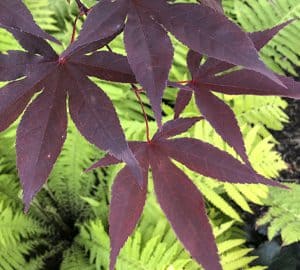
Japanese Maples
The diverse beauty of Japanese maples has captivated gardeners for centuries. During the Edo era in Japan, over 250 named cultivars were selected and grown. Today, there are over 1,000 varieties of different sizes, shapes and hardiness levels.
Japanese maples are especially prized for the diversity of size, shape and colour of foliage. Foliage colour changes with the season, and many are especially spectacular in the autumn. Japanese maples are usually categorized according to leaf type. These include palmate types: large leaves that look like your hand. Deeply divided types: the leaves are divided down to the petiole. Dissected leaf types: the leaves are fine and deeply dissected or serrated. Other: these include variegated leaf types and linear lobum or line-leaf types.
Our Top Japanese Maple Varieties
Japanese maples are one of Canadale’s specialties, known for their stunning foliage and year-round interest. Here are some of our most popular and reliable varieties:
Bloodgood
A longtime favourite, Bloodgood features deep red leaves that hold their colour throughout the season and bring dramatic contrast to the garden.
Fireglow
Similar to Bloodgood but with a slightly brighter red hue and a more compact size, making it a great option for smaller landscapes.
Emperor 1
This fast-growing and hardy variety has rich purple-red leaves that turn a vibrant red in fall. Its later leaf-out helps avoid damage from late spring frosts.
Crimson Queen
A beautiful weeping variety with finely cut, deep red foliage. Its graceful, cascading form makes it a standout feature in any garden.
Tamukeyama
Another cascading variety, Tamukeyama offers dark purple leaves that transition to fiery red in the fall and hold up well in summer heat.
Twombly’s Red Sentinel
A unique upright, columnar variety that keeps its red foliage all season. Perfect for tight spaces or as a vertical accent.
Availability may vary — products and quantities change with the season here at Canadale. Check with us in-store for current availability.
Planting & Care of Japanese Maples
Where to Plant Japanese Maples
Japanese maples grow well in our climate if a few basic principles are followed. The most important is to select a sheltered planting site that is out of the severest northwest winter winds. If it must be exposed to wind, ensure the tree is well wrapped with burlap in the winter months. Japanese maples grow well in any well-drained soil. They grow in full sun to almost full shade and will do best with protection from mid-day sun. The amount of light will affect the leaf colour; red leaf types will be more colourful in higher light conditions.
Planting:
Mix one part of peat moss with three parts of soil in the planting hole, which should be much larger than the root ball. Water heavily at the time of planting and mulch the entire area with a two-inch layer of bark or leaves to ensure water retention and keep the roots cool. Only moderate amounts of fertilizer, such as a transplanter with a formula in a ratio of 5-15-5, should be used at planting time.
Fertilizing & Trimming of Established Plants:
Once established, Japanese maples may be lightly fertilized only in the early spring (April) with 4-12-8 fertilizer or 15-30-15 water-soluble mixture. Major structural trimming may be done before the new leaves unfurl in spring. Lighter pruning can be accomplished any time in June after the first major flush of growth begins.
Diseases:
Japanese maples are subject to very few pests. Aphids, leaf cutters and rollers may appear in the spring and can be effectively treated with an approved spray. (Ask the experts at your local garden centre to recommend an appropriate product). Mildew may appear in humid conditions.
Winter Protection:
Wrap Japanese maples with burlap for at least the first three years in the garden. In more exposed locations, wrap every year. Heavy watering just prior to freeze-up will help to guard against water loss in winter. An extra heavy layer of mulch will also help to protect the root system.
